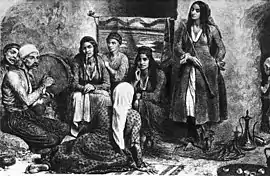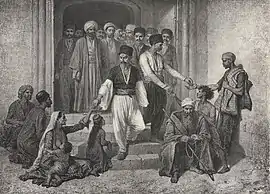Crimean Roma
The Crimean Roma (also known as Crimean gypsies, Tatar gypsies, Ayuji (Crimean Tatar for 'bear cub'), Krymy, or Çingene[lower-alpha 1]) are a sub-ethnic group of the Muslim Roma. Currently, they live in many countries of the former Soviet Union, including Russia. They speak the Crimean Tatar language and their own Crimean Romani dialect.[1] Crimean Roma traditionally practice Islam.
 Family of Crimean Roma in the Stavropol Governorate. Pre-Russian Revolution. | |
| Languages | |
|---|---|
| Crimean Romani, Crimean Tatar, Russian | |
| Religion | |
| Sunni Islam | |
| Related ethnic groups | |
| Ursari, Ruska Roma |
| Part of a series on |
| Romani people |
|---|
|
Romani people by sub-group |
|
Romani diaspora by country
|
|
History and ethnogenesis

Gypsies arrived on the territory of Crimea with the Golden Horde. In the Crimean Khanate, the Roma, like people of other nations, were not harassed; the authorities did not persecute them and they were not treated with contempt.[2] In Crimea, they led a sedentary and semi-sedentary lifestyle, engage in productive labor and music.[2] In the 18th century, Islam became the traditional religion of the Crimean gypsies. Roma researcher Nikolai Stieber wrote in his essay on Roma in Crimea:
—Nikolai Stieber[2]
Settlement and migration

Crimean Roma lived in Crimea and in the Kuban steppe, which was part of the Crimean Khanate. The Crimean Roma were the first Roma to appear in the Kuban steppe. Today, the descendants of the first Roma who settled in the Kuban do not call themselves Crimean gypsies, but Kuban gypsies, while they retain the Crimean dialect of the Romani language and follow Islam and boys are circumcised.
From 1854 to 1862, Tatar Roma together with the Crimean Tatars were expelled to the Ottoman Empire. Most settled in Northern Bulgaria, especially in Dobruja, near the Danube, and in the Vidin region.
Crimean Tatar intervention saved the lives of Crimean Muslim gypsies from the Nazis, but in 1944, the Crimean Roma, as well as the Crimean Tatars, were deported to Central Asia, due to the fact that most of the Crimean Roma were registered as Crimean Tatars in their Soviet passports.
In 1948–1949 the Crimean Roma began to return to Crimea.
Currently, the majority of Crimean Roma live outside of Crimea in Krasnodar Krai, Russia. There are also families living in Ukraine, namely in Kyiv, Zhytomyr, Vinnytsia, and Kherson.
Demographics
According to the 2014 Crimean census, the Roma were the youngest ethnic group in Crimea with an average age of 28.3 years, while the average age of the entire republic was 40.9 years.[3]
See also
Note
- Russian: чингене; anglicized as 'Chingen'
References
- Marushiakova, Elena; Vesselin, Popov (2004). "Segmentation vs. consolidation: The example of four Gypsy groups in CIS" (PDF). Romani Studies. 14 (2): 145–191. doi:10.3828/rs.2004.6.
- "Крымские цыгане, или чингене: кто они?" (in Russian). avdet.org. Archived from the original on 2019-08-02. Retrieved 2019-12-27.
- "Демографические перспективы крымских татар | Газета 'Голос Крыма new' — официальный сайт". Archived from the original on 2017-10-26. Retrieved 2017-10-25.
Sources
- Toropov, V. G. (2009). Crimean Roma: Language and Folklore (PDF). Translated by Stepanov, A. V. Unona Publishing House. ISBN 978-5-89729-118-2. Archived (PDF) from the original on 2023-04-21.
- "Crimean Gypsies". Poemas del río Wang. June 2014.
{{cite web}}: CS1 maint: url-status (link) - "Oral History of Tatar Roma of Bulgaria". Roma: past, present, future. Khristo Ki︠u︡chukov, Elena Marushiakova, Veselin Popov, Gypsy Lore Society. Annual Meeting. Muenchen: Lincom GmbH. 2016. ISBN 978-3-86288-736-1. OCLC 985346229.
{{cite book}}: CS1 maint: others (link) - Smirnova-Seslavinskaya, M. V. (November 2016). "ROMA MIGRATION IN THE SOUTHERN REGIONS OF THE RUSSIAN EMPIRE AND CRIMEA, FORMATION OF THE CRIMEAN ROMA (KRYMY) COMMUNITY" (in Russian).
{{cite journal}}: Cite journal requires|journal=(help)